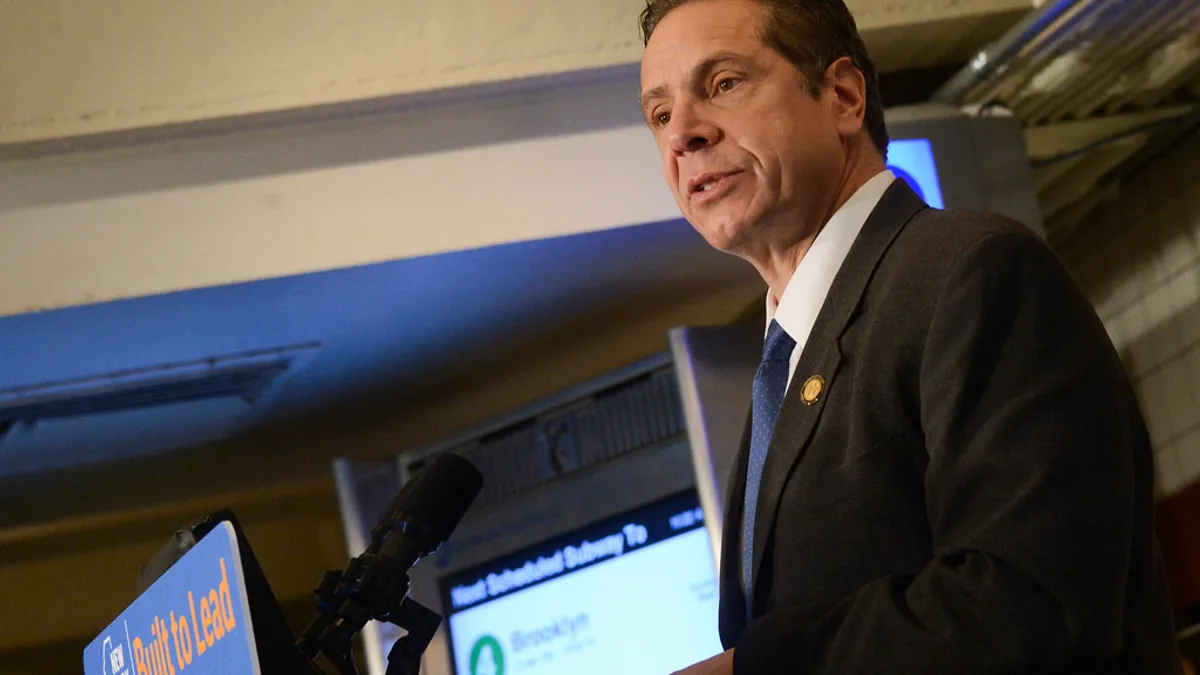Dive Brief:
- Seven Northeast states are creating a buying consortium to purchase roughly $5 billion worth of medical equipment and supplies, including ventilators and personal protective equipment, to try to make up for a lack of centralized procurement infrastructure during the COVID-19 pandemic, the states announced Sunday.
- Connecticut, Delaware, Massachusetts, New Jersey, New York, Pennsylvania and Rhode Island are aiming to use their combined purchasing power to drive down prices for the in-demand supplies for their combined 53.6 million residents. The group will also coordinate planning on gradually lifting social distancing requirements as the number of confirmed U.S. deaths from the novel coronavirus passed 67,000 on Sunday.
- Along with the Northeastern states, the Democratic governors of California, Oregon and Washington are working together to reopen their economies, as are Midwestern governors in Indiana, Illinois, Ohio, Minnesota, Michigan and Wisconsin.
Dive Insight:
States have been caught in a bidding war against each other, the federal government and private entities for medical equipment as the coronavirus continues to spread in the U.S. Fierce competition for supplies like masks, isolation gowns, nasopharyngeal swabs, ventilators and more has led states to shell out prices far above market rates. For example, the price tag of a single ventilator has snowballed from $12,000 to $65,000, according to the comptroller of Illinois.
The new regional supply chain is an attempt to tamp down on those skyrocketing prices as demand is unlikely to let up anytime soon, with some public health experts forecasting a return of the coronavirus in the fall.
"When you put all those hospitals together, all that public health capacity together — which will make us more competitive in the international marketplace — I believe it will save taxpayers money," New York Gov. Andrew Cuomo said in a press conference Sunday.
"I also believe it will help us actually get the equipment because we have trouble still getting the equipment and just buying the equipment because these vendors on the other side they're are dealing with countries, they're dealing with the federal government —why should they do business with one state when they can do business with an entire country?"
The partnership will be especially beneficial to the smaller states involved in the partnership, but all of the state's involved should benefit from the increased purchasing power.
"We're much stronger together, I wouldn't mind having some of that New York purchasing power, thanks for sharing that with Connecticut going forward,"Connecticut Governor Ned Lamont said during the press conference.
New York is also requiring all hospitals in the state to have a 90-day supply of PPE at the levels sufficient to handle COVID-19-level capacity, Cuomo said at the press conference.
Tensions have swirled between President Donald Trump and embattled states that have called on the federal government to quarterback the COVID-19 response. A handful of governors have asked the administration to centralize procurement through the Federal Emergency Management Agency, to take point in ordering equipment and disbursing it to areas of greatest need.
But Trump has taken a backseat approach, putting the onus on states as governors report losing equipment negotiations to FEMA, which can pay higher prices.
States have few avenues for relief among the widespread shortages. The Strategic National Stockpile of emergency medical supplies has been largely depleted since April. Trump has invoked the Defense Production Act, a wartime authority allowing the president to force manufacturers to ramp up production of critical supplies, to mitigate some supply chain issues for ventilators and N95 masks, but marked deficits remain.
The problem partially stems from the U.S. reliance on global sources for medical equipment, as the country traditionally takes advantage of low-cost manufacturing abroad. The limited supply for many of these items if primarily located in China, Cuomo said.
But despite the lack of equipment, protective gear and COVID-19 tests, a hodgepodge of red states have begun reopening their businesses and public spaces, including Georgia, Florida and Texas.
In a bright spot for the state, New York's hospitalization rate dipped below 10,000 people on Sunday for the first time since mid-March as the number of new cases declined, and the state reported its lowest single-day death rate in weeks. However, more than 19,000 people have died in New York from COVID-19 to date, though officials say the real figure is likely much higher.
Moving forward, New York is requiring hospitals have a 90-day supply of PPE and other key medical supplies at a "rate of use during the worst of this crisis" to ensure enough masks and equipment in event of a resurgence, Cuomo said.















